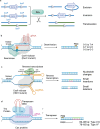Precise genome-editing in human diseases: mechanisms, strategies and applications
- PMID: 38409199
- PMCID: PMC10897424
- DOI: 10.1038/s41392-024-01750-2
Precise genome-editing in human diseases: mechanisms, strategies and applications
Abstract
Precise genome-editing platforms are versatile tools for generating specific, site-directed DNA insertions, deletions, and substitutions. The continuous enhancement of these tools has led to a revolution in the life sciences, which promises to deliver novel therapies for genetic disease. Precise genome-editing can be traced back to the 1950s with the discovery of DNA's double-helix and, after 70 years of development, has evolved from crude in vitro applications to a wide range of sophisticated capabilities, including in vivo applications. Nonetheless, precise genome-editing faces constraints such as modest efficiency, delivery challenges, and off-target effects. In this review, we explore precise genome-editing, with a focus on introduction of the landmark events in its history, various platforms, delivery systems, and applications. First, we discuss the landmark events in the history of precise genome-editing. Second, we describe the current state of precise genome-editing strategies and explain how these techniques offer unprecedented precision and versatility for modifying the human genome. Third, we introduce the current delivery systems used to deploy precise genome-editing components through DNA, RNA, and RNPs. Finally, we summarize the current applications of precise genome-editing in labeling endogenous genes, screening genetic variants, molecular recording, generating disease models, and gene therapy, including ex vivo therapy and in vivo therapy, and discuss potential future advances.
© 2024. The Author(s).
Conflict of interest statement
The authors declare no competing interests.
Figures





Similar articles
-
Trojan Horse-Like Vehicles for CRISPR-Cas Delivery: Engineering Extracellular Vesicles and Virus-Like Particles for Precision Gene Editing in Cystic Fibrosis.Hum Gene Ther. 2025 Aug;36(15-16):1021-1052. doi: 10.1089/hum.2024.258. Epub 2025 Apr 28. Hum Gene Ther. 2025. PMID: 40295092 Review.
-
Evolution of Prime Editing Systems: Move Forward to the Treatment of Hereditary Diseases.Curr Gene Ther. 2025;25(1):46-61. doi: 10.2174/0115665232295117240405070809. Curr Gene Ther. 2025. PMID: 38623982 Review.
-
Advanced viral genome in vitro Cas9 editing (AdVICE): an overnight method for traceless and limitless manipulation of adenoviral and vector genomes with large transgenes.J Virol. 2025 Jun 17;99(6):e0226524. doi: 10.1128/jvi.02265-24. Epub 2025 May 21. J Virol. 2025. PMID: 40396759 Free PMC article.
-
Short-Term Memory Impairment.2024 Jun 8. In: StatPearls [Internet]. Treasure Island (FL): StatPearls Publishing; 2025 Jan–. 2024 Jun 8. In: StatPearls [Internet]. Treasure Island (FL): StatPearls Publishing; 2025 Jan–. PMID: 31424720 Free Books & Documents.
-
Cell-Penetrating Peptides and CRISPR-Cas9: A Combined Strategy for Human Genetic Disease Therapy.Hum Gene Ther. 2024 Oct;35(19-20):781-797. doi: 10.1089/hum.2024.020. Hum Gene Ther. 2024. PMID: 39276086 Review.
Cited by
-
Reporter Alleles in hiPSCs: Visual Cues on Development and Disease.Int J Mol Sci. 2024 Oct 13;25(20):11009. doi: 10.3390/ijms252011009. Int J Mol Sci. 2024. PMID: 39456792 Free PMC article. Review.
-
Enhancing precision in cancer treatment: the role of gene therapy and immune modulation in oncology.Front Med (Lausanne). 2025 Jan 13;11:1527600. doi: 10.3389/fmed.2024.1527600. eCollection 2024. Front Med (Lausanne). 2025. PMID: 39871848 Free PMC article. Review.
-
Dual sgRNA-directed knockout survivin gene expression using CRISPR/Cas9 technology for editing survivin gene in triple-negative breast cancer.Narra J. 2024 Dec;4(3):e1177. doi: 10.52225/narra.v4i3.1177. Epub 2024 Nov 16. Narra J. 2024. PMID: 39816115 Free PMC article.
-
CRISPR genome editing using a combined positive and negative selection system.PLoS One. 2025 May 6;20(5):e0321881. doi: 10.1371/journal.pone.0321881. eCollection 2025. PLoS One. 2025. PMID: 40327602 Free PMC article.
-
Targeted in vivo gene integration of a secretion-enabled GLP-1 receptor agonist reverses diet-induced non-genetic obesity and pre-diabetes.Commun Med (Lond). 2025 Jul 9;5(1):269. doi: 10.1038/s43856-025-00959-8. Commun Med (Lond). 2025. PMID: 40634590 Free PMC article.
References
Publication types
MeSH terms
Substances
Grants and funding
LinkOut - more resources
Full Text Sources
Other Literature Sources

